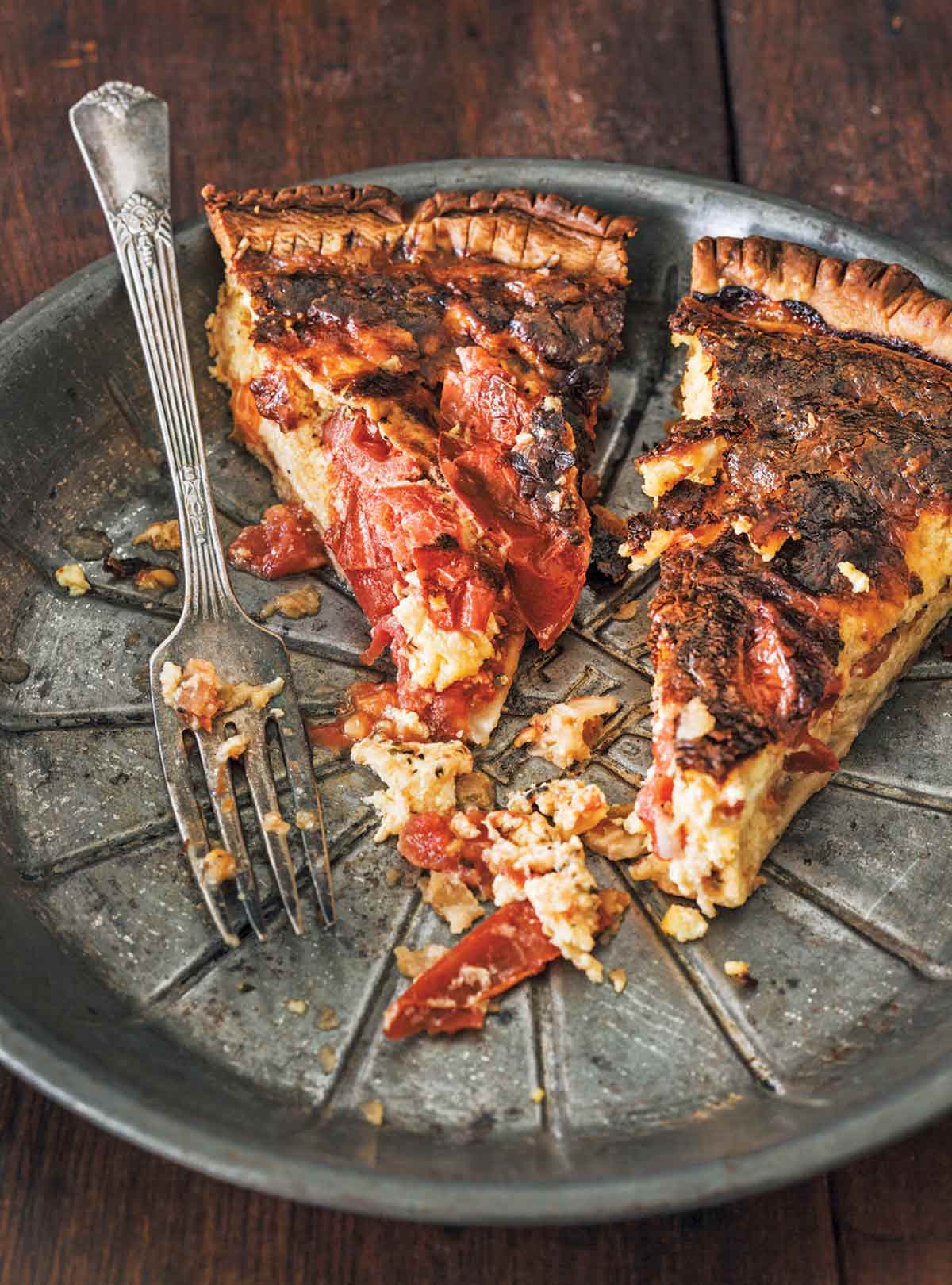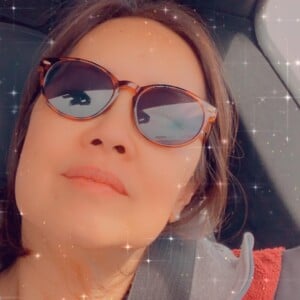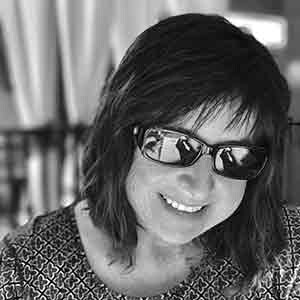
This roasted tomato quiche recipe is going to blow any prior assumptions or, dare we say, negative connotations you may have been harboring about quiche. As the author says, “I think folks are so scarred from cold, rubbery quiches sitting in glass cases in overpriced gourmet marketplaces that a tiny warning bell goes off in their minds if I even mention it.” Nods. We understand. But we think this late-summer recipe, loaded with fresh tomatoes, basil, and cheese and roasted until its fairly oozing awesomeness, will do great things for quiche’s name in your household. Just do yourself a favor and only make this with beauteous tomatoes straight from your garden or the farmers market. None of those insipid January hothouse tomatoes, please. And then bear in mind that this soulful and satiating quiche goes perfectly with chilled wine at dinner. Or with even more wine at brunch.–Renee Schettler
Why is My Quiche Watery?
There’s nothing more deflating than a quiche that has a watery filling or a soggy crust. A runny filling is one thing–generally, that just means that it’s been undercooked and can be fixed by a little more time in the oven. A watery filling happens when your quiche is set but weeps a watery liquid. Here are the top reasons that can happen.
- You overbaked it. That sounds counterintuitive, we know, but when you overcook eggs, their proteins begin setting too hard and forcing out water.
- You used thin cream (or thin milk). This recipe calls for heavy cream and there’s a reason for that, beyond just the sheer deliciousness of it. Thin cream has far more water, and less fat, than the thick stuff and it doesn’t have anyplace to go…except all over your plate. You can substitute milk for cream but remember to use one with lots of fat.
- You used the top or bottom rack in the oven. Quiche needs to be cooked evenly from the top and bottom to avoid getting soggy. Make sure that you’re using the middle rack and cooking for at least 45 minutes.

Tomato Quiche
Ingredients
- About 1 pound tomatoes, sliced 1/4 inch (6 mm) thick (about 10 to 12 tomato slices from 2 to 3 not gigantic tomatoes)
- Extra-virgin olive oil, for drizzling
- 1 tablespoon finely chopped basil leaves, or 1/8 teaspoon dried basil
- 1/8 teaspoon dried oregano, (optional)
- Salt and freshly ground black pepper
- 5 large egg yolks
- 1 1/2 cups heavy cream
- One (9-inch) store-bought or homemade pie crust
- 1 cup provolone cheese, shredded
- 1 cup Parmigiano-Reggiano cheese, grated
Instructions
- Preheat the oven to 425°F (218°C).
- Spread the tomato slices in a single layer on a rimmed baking sheet, being careful that the slices don't overlap. Drizzle the slices with enough oil to generously coat them, turning to slick both sides, and then sprinkle them with the basil, oregano, salt and pepper. Roast until the tomatoes start to shrink, 15 to 20 minutes. Let cool on the baking sheet for 30 minutes.
- In a medium bowl, whisk the egg yolks until light and fluffy, and then whisk in the heavy cream.
- Arrange half the roasted tomato slices in a single layer in the bottom of the pie crust. Sprinkle half of each cheese over the tomatoes. Repeat the layering of tomatoes and cheese and slowly pour the egg mixture over the top, letting it fill in all the nooks and crannies.
- Bake the quiche until golden brown on top and set in the center, or until a toothpick inserted in the center comes out clean, 30 to 60 minutes, depending on the wateriness of your tomatoes and exactly how thick your pie plate is. Check on the quiche after 30 minutes and then again at 45 minutes and if the crust or the filling are sufficiently browned, loosely cover the quiche with foil until it finishes baking. Let the quiche rest at room temperature for 30 minutes before slicing it into wedges. The quiche is far more fabulous when served warm as opposed to cold. (Don't even think about serving leftovers straight from the fridge.)

Explore More with AI
Nutrition
Nutrition information is automatically calculated, so should only be used as an approximation.
Recipe Testers’ Reviews
This roasted tomato quiche tasted great. Tomatoes are just coming into season in a big way here, and it’s great to have this recipe because it seems so adaptable. Cooking the tomatoes first prevents the water from the tomatoes leaking into the quiche as it cooks. There’s so much cheese—and a couple different types of cheese—that this recipe can’t help but be great. I opted for fresh basil and used closer to 1 teaspoon to cover all the tomato slices. I didn’t use oregano.
It took about 2 fist-size, not gigantic, tomatoes to make 11 slices. I made my own whole-wheat crust because I thought it might go nicely with the tomatoes. It was great, and perfect with the savory nature of this dish. Would I make this again? Definitely. I would probably add basil directly to the quiche, as well. I would likely use the oregano and maybe vary the cheeses. This is definitely a versatile recipe.
The one thing I would change would be to reduce the temperature from 425°F to maybe 375°F or even 350°F. At 425°F, it was mostly done by 30 minutes and the top was starting to get quite brown. I covered it with foil to avoid burning the top. The quiche only needed another 15 minutes of cooking time.
I really like this tomato quiche recipe—it’s pretty easy and tastes great! I cut 3 tomatoes into 14 slices, but I think I could’ve used more tomatoes in the filling. I used herbes de Provence instead of dried basil and oregano because that’s what I had on hand. I used grated feta cheese instead of provolone (also what I had on hand), and it worked fine. The tomatoes took around 15 minutes to roast. My tart took 65 minutes to cook through. I served it lukewarm, and it had deflated a lot by the time I served it. Tasted great, though.
This roasted tomato quiche recipe is very simple and vegetarian-friendly. It makes a very rich and mildly flavored quiche. It doesn’t weep at all, not even on the second day, which is sometimes a problem with vegetable-laden quiches. I think the combination of the rich egg yolk and cream filling and pre-roasting the tomatoes helps ensure that. The tomatoes roast up nicely in 20 to 25 minutes, though smaller ones might of course take less time, so it’s worth checking from 15 minutes onward.
The quiche was golden brown and passed the knife test at 40 minutes. The quiche is a bit too rich for my taste. I think I prefer a recipe that uses whole eggs rather than all yolks, as this was almost buttery in a too-rich way. The provolone melted nicely but isn’t as interesting a cheese as Gruyère. Playing with the cheese mixture is easy to do, though. The quiche should be served warm.
I used lovely large tomatoes from the farmers’ market weighing about 1 pound, 4 ounces, about 2 tablespoons combined fresh basil and oregano, and for the first time in my almost 77 years, a store-bought pie crust. Loved the ease of that! The tomatoes were nicely roasted after 20 minutes. The assembly was easy. Quiche is quiche.
My common sense told me that the oven should not be at 425°F. I fudged a little and used 400°F. I should’ve know better. After 30 minutes, the aroma was so wonderful that I peeked. Oh my! Very brown beautifully crimped edges, but a more than golden brown top. What to do? Another 45 minutes in the oven, and we would be raiding the freezer for an alternative dinner. So I turned off the oven and took it out. Again, I should’ve know better. We waited for a half hour as directed. It was so soft that it was hard to cut, but we agreed that it tasted wonderful and was not too uncooked to eat. The next day I nuked a slice and had it for lunch, and while I’ve certainly made better-looking quiche, this was very good, maybe even better, reheated. I’ll make this recipe again but with the oven temperature at 350°F.














This is one darn good quiche. The bold roasted tomato flavor enveloped in soft, melt-away cheese and cream is a beatiful combination.
I couldn’t agree more with you, Melissa.
How can you put a filling in raw dough? Recipe doesn’t mention anything about pre baking the crust. Good thing I know how to cook.
Sharon, we understand that many tarts require parbaking, but this one doesn’t. We tested it as the recipe appears above and you can see our recipe testers’ very pleased results.
just a question– why only the egg yolks and not whole eggs? i made blue apron quiche w whole eggs and it turned out really wonderful.
Shelley, it’s just the preference of the author. It makes for a richer quiche. You can use whole eggs, but we didn’t test it that way, so we can’t assure you a simple swap out will work.